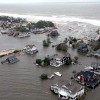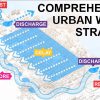Climate and Energy
There is growing recognition, in New Jersey and across the world, that a changing climate is a serious problem that will require urgent action. Concerns about carbon emissions have more and more people talking seriously about hybrid or electric cars, renewable energy, green building technology and other ways to reduce greenhouse gases and conserve energy. There is one crucial piece of the puzzle, however, that is often omitted from this conversation: the role of land use in influencing carbon emissions.
Land use—the decisions we make about where and how to develop—has a profound and lasting effect on our greenhouse gas emissions and energy use. And unlike cars or appliances, which can be replaced every few years if a newer, more efficient model comes along, the decisions we make about how to develop, and the impacts these decisions have on climate and energy, will be with us for generations. Poor land-use decisions not only lead to poor outcomes today, but they also limit our ability to reduce these impacts far into the future.

2023 was a year full of many unpredictable environmental events ranging from major rainfall to extreme heat to a collapsed highway overpass. Our daily newsletter “What We’re Reading” brings our readers the most up-to-date articles covering our New Jersey Future issue areas and major developments in the Garden State.

“Lenape means ‘the original human’, and that is where we need to get back to,” Chief Vincent Mann expressed, adding, “[reconnecting with the land] would provide us a way to encourage the people of tomorrow to take what we are sacrificing to create for them to further the future.” Indigenous people have a rich history of interacting in harmony with the environment.

“It doesn’t matter if we make every vehicle electric, and it doesn’t matter if we turn of all power plants; climate change will still get worse,” exclaimed Shawn LaTourette, the Commissioner of the New Jersey Department of Environmental Protection (NJDEP), during the 2023 Planning and Redevelopment Conference plenary, The State of Planning and Redevelopment in New Jersey, co-sponsored by New Jersey Future and the NJ Chapter of the American Planning Association.

Electric bicycles, along with programs intended to incentivize their adoption, are rolling out across the country and New Jersey can’t afford to be left behind in this transportation revolution. Transportation emissions, which account for more than a third of all total greenhouse gas emissions in the state, are a critical target for climate change mitigation, necessitating the use of every tool to help us drive less.

“As New Jersey works to advance decarbonization and resilience efforts, we must ensure that residents are able to make informed decisions for themselves, and their families, in the wake of growing climate risks,” said New Jersey Future (NJF) Policy Manager Kim Irby, at the August 11th joint legislative committee hearing hosted by State Senator Bob Smith (D-17) and State Assemblyman James Kennedy (D-22) last Thursday.

A one-hour webinar explaining a new, parcel-based tool that assesses financial vulnerability to coastal flooding and sea-level rise. Friday, May 15, 2015, noon – 1:00 pm.
An interim report, three years after Hurricane Sandy, on New Jersey Future’s groundbreaking local recovery planning manager program, including lessons learned and recommendations. October 2015.
Oct. 28, 2014 — Two years after the devastation wrought by Hurricane Sandy, many of New Jersey’s coastal communities continue to struggle with recovery and rebuilding efforts. The highest community priority is to get people back into their homes, re-establish business operations and return to life as close to normal as possible. The elected officials who have led these efforts are hardworking heroes. But it’s also clear that recovery decisions made without a clear understanding of future risks can move people back into harm’s way, build infrastructure that will be damaged again, and waste taxpayer dollars.
Sept. 4, 2013 — Of all the recommendations that came out of President Obama’s Sandy Rebuilding Task Force Strategy, there is one that will help inform much of the other recovery planning that is currently being done: Incorporate projected sea-level rise into all decision-making.

2016 Smart Growth Awards: A large-scale, integrated design strategy will manage water along the Hudson riverfront, for both disaster mitigation and long-term growth, delivering multiple community co-benefits.
See all New Jersey Future Blog posts and articles in this category »
Reports, Presentations and Testimony
- 08/06/2019: Comments on Solar Siting Element of Energy Master Plan
- 07/15/2019: Comments on Draft Energy Master Plan
- New Jersey Future Resilient Coastal Communities Phase 2 Report 5-22-18
- New Jersey Future Resilient Coastal Communities Phase 2 Report appendices 5-22-18
- 02/01/2019: Comments on Phase 1 Stormwater Rule Amendment
- 01/30/2019: Testimony on CAFRA Center Extension
- 10/11/2018: Recommendations on Proposed Energy Master Plan
- 09/20/2018: Clean and Reliable Transportation Comments
- Mystic Island HIA Report 6-7-16
- New Jersey Future Resilient Coastal Communities Project Report Appendix 6
- New Jersey Future Resilient Coastal Communities Project Report Appendix 4
- New Jersey Future Resilient Coastal Communities Project Report Appendix 3 Figures
- New Jersey Future Resilient Coastal Communities Project Report 2017
- 08/15/2017: Statement on Rescission of Flood Risk Management Standard
- 08/10/17: Broccoli joint committee climate change hearing testimony
- 08/10/2017: Testimony for NJ Joint Environment Committee
- New Jersey Future 2017 Gubernatorial Platform
- Little Egg Harbor Township Vulnerability Assessment Report 02-2015
- Strategic Recovery Planning Report Maurice River 05-2015
- Strategic Recovery Planning Report Commercial 12-2015
- NJFuture-In-Deep-10-15-WEB
- Risk analysis public mtg presentation Tuckerton-Little Egg Harbor 4-14-15
- Strategic Recovery Planning Report Tuckerton 4-15-15
- Sea Bright exposure analysis
- New Jersey Future Stormwater Utilities Report 9-14 (Intern Report)
- Agenda for Change
- 03/05/2014: Sandy Action Plan Amendment Planning Letter
- 03/05/2014: Sandy Action Plan Amendment Resiliency Letter
- 02/12/2014: Testimony on Proposed Sandy Plan Still Puts Taxpayer Dollars at Risk
- 03/19/2013: New Jersey Future CDBG-DR comments
- JDrill Outline for APA-NJ 11-4-2011
- RSolomon Solar Siting Presentation APA-NJ 11-4-2011
- LSpecca Solar Presentation APA-NJ 11-4-2011
- Smart Growth NJ August 2011 Poll Report
- Assessment of Solar Siting in New Jersey 5-11 (Intern report)
- Presentation: Land Preservation Using Off-site Clustering 03-19-11











